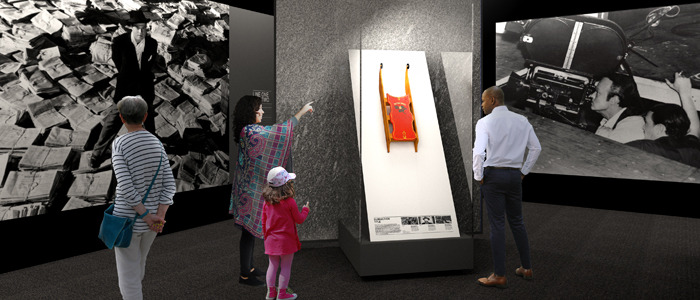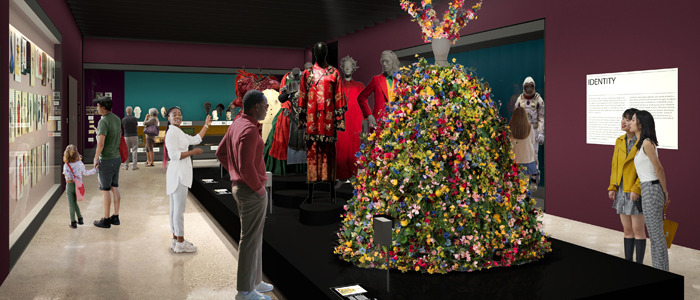The Academy Museum Of Motion Pictures Opens This Fall: Here's What You Need To Know
"How could there be no film center in the global center of film?"
That was a question Netflix CEO Ted Sarandos had when he first moved to Los Angeles in the late 1990s and discovered that the entertainment capital of the world was sorely lacking, in his words, "a place to dive deeper, to learn more, to fully immerse myself in the stories behind the movies." After more than 15 years of development, the Academy Museum of Motion Pictures is finally poised to open this fall and become the world's premier museum dedicated to the art and science of movies.
Today, /Film attended a virtual tour of the new facility and learned about the programs and exhibitions its executives and programmers have planned. Read on for everything you need to know about the highly anticipated museum.
In today's presentation, Oscar winner Laura Dern narrated a virtual tour of the 300,000 square foot, two-building campus connected by glass bridges and located in the Miracle Mile district of Los Angeles. There will be a myriad of galleries and exhibitions on display when the museum opens for in-person attendance on September 30, 2021, but surprisingly, it sounds like the museum is not interested in only presenting a squeaky-clean image to the world. Dern mentioned multiple times that various areas and installations will specifically address "less proud moments in the histories of the Academy and the film industry." There's a gallery called Identity which explores "examples of how hair and makeup have been used to perpetuate racial stereotypes in the movies," another area which delves into "some of animation's most troubling histories, including depictions of harmful racial stereotypes and the objectification of female characters," and, in a two-gallery experience devoted to the Academy Awards, the museum "will not shy away from problematic histories, including OscarsSoWhite, the lack of female representation, and Hattie McDaniel's mistreatment at the Oscars ceremony."
Highlights
The museum's core exhibition is called Stories of Cinema and will be a three-floor exhibition "that explores the celebratory, complex, diverse, and international stories of the people that make motion pictures and the films they create." This will be a dynamic, ever-changing exhibition, but when the museum opens, it will begin with an introductory corridor with floor-to-ceiling projections teasing the films that will be highlighted in the rooms beyond. Then guests will see six vignettes devoted to specific movies and movie artists: Citizen Kane (the actual Rosebud sled will be on display), Real Women Have Curves, editor Thelma Schoonmaker, Bruce Lee, cinematographer Emmanuel "Chivo" Lubezki, and pioneering Black filmmaker Oscar Micheaux.
There will be a series of galleries called The Art of Moviemaking which "kick off with director's inspiration, a space co-curated with the directors themselves." First up will be a collaboration with Spike Lee, who seems to be transporting a significant portion of his collection from Brooklyn to Los Angeles for this experience. "My collection is a sneak peek into my loves, my influences, and it's for the whole world to see," he said in a video message.
There's a gallery devoted to the creation of a single film, focusing on the mechanics and creation of story and taking "a deep dive into the collaborative process of moviemaking." The opening film will be The Wizard of Oz, and visitors will learn "about the film's many contributors, from executives to special effects artists, cinematographers, to costume designers, and more."
There will also be a gallery devoted to casting and performance that will feature screen tests, audition tapes, and casting cards from people like Henry Thomas, Taraji P. Henson, Chiwetel Ejiofor, Hilary Swank, and more. A sound-themed gallery will showcase a short film made at Skywalker Sound that "breaks down key components and layers of sound design in Raiders of the Lost Ark." And speaking of sound, Oscar-winning sound designer Ben Burtt has created an original cylindrical installation devoted to the evolution of space in the movies that's described as "a dynamic 320 degree experience."
Composers will be represented as well, with a sound chamber devoted to the work of a single composer at a time. Starting things off will be Hildur Guðnadóttir, who won an Oscar for her score for Joker. You'll be able to hear clips from her scores, as well as new music created specifically for this space.
On the third floor, the Stories of Cinema exhibition starts with an installation space that will be co-curated with a revolving roster of international film artists. Pedro Almodovar is responsible for the opening installation, which "features twelve screens highlighting themes frequently found in his films: musicals, religion, melodrama, and mothers, just to name a few."
There's an effects gallery which will focus on the influence of Ray Harryhausen and Willis O'Brien, the significance of movies like Jurassic Park and Terminator 2, and more, as well as an "Encounters" gallery populated with original set pieces, costumes, and characters from sci-fi, fantasy, and horror films.
And as we've previously covered, the Academy Museum will be the home of the first North American retrospective on Hayao Miyazaki. Visit the Academy's website for more information.
Pre-Programming and Inaugural Programming
There will also be several pre-opening virtual programs that will begin just days before this year's Oscars ceremony. On April 22, the Academy Museum's website will host Breaking the Oscars Ceiling, "a conversation hosted by Academy Museum trustee Diane von Furstenberg and moderated by the Academy Museum's Jacqueline Stewart, who will be speaking with women who achieved historic Oscars milestones. Guests include actor Sophia Loren, actor and comedian Whoopi Goldberg, actor Marlee Matlin, and singer-songwriter Buffy Sainte-Marie."
Additional virtual programs will include the following (although no specific dates or times have been rolled out yet):
The virtual screenings themselves will only be available in the United States at this time, but the subsequent conversations will be available to access from anywhere in the world.
When the museum finally opens its doors, guests will be able to engage with film series that celebrate a wide selection of cinematic perspectives, including:
The museum will also present conversations, panels, symposia, and lectures several times a month in its theaters, such as:


